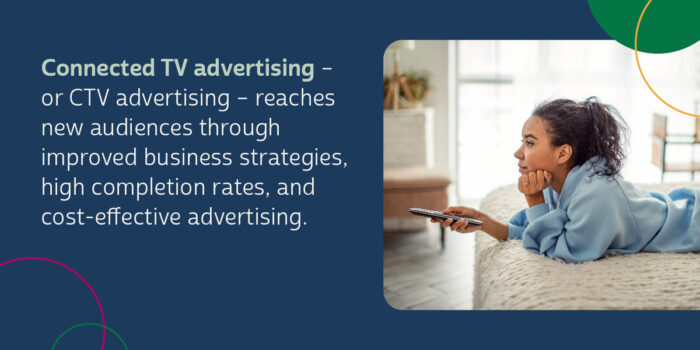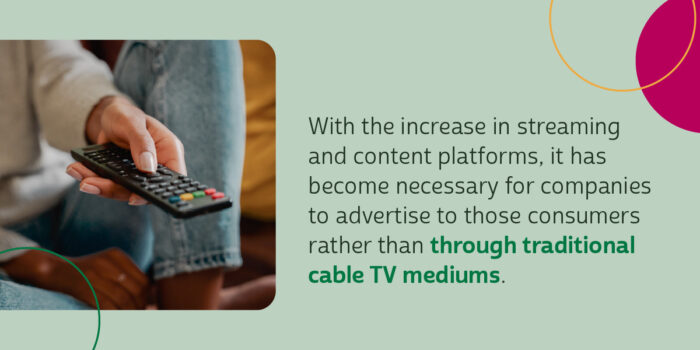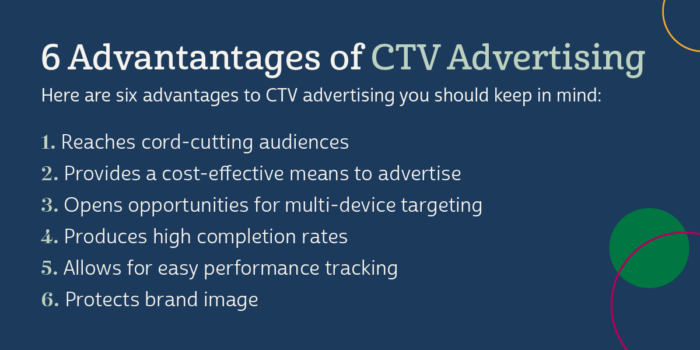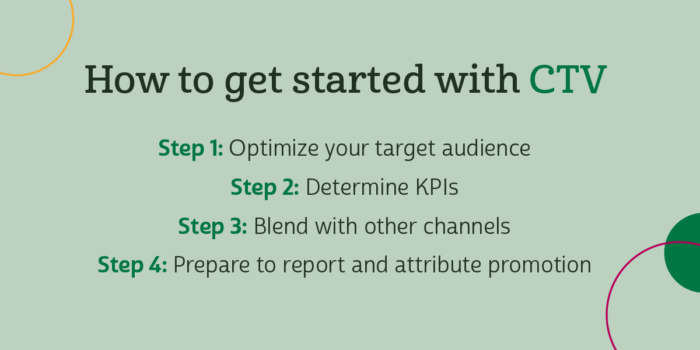Connected TV advertising — or CTV advertising — reaches new audiences through improved business strategies, cost-effective advertising and high completion rates. As more and more consumers watch content across multiple platforms, your business has increased opportunities for CTV advertising on laptops, televisions, gaming consoles and cellular devices. Data is a critical part of the success of your CTV advertising strategy. Explore CTV advertising and how data can power your success.
What Is CTV Advertising?

Today’s consumers have shifted away from cable TV and opted for reliable, accessible streaming platforms like Netflix, Amazon Prime, Hulu, Disney+ and HBO Max. With the increase in streaming and content platforms, it has become necessary for companies to advertise to those consumers rather than through traditional cable TV mediums. That is where CTV advertising plays a critical role.
CTV advertising refers to video ads that are displayed via a streaming service. These ads are viewed on a TV, meaning they are either watched on a smart TV or via a connected device like Roku. You might see a CTV ad during the commercial break of a show streaming on Hulu.
CTV advertising offers different benefits than traditional TV advertising. It allows companies to reach more customers, including those who do not have a cable or satellite connection. Anyone who streams content on a specific platform can see the ad. CTV advertising also allows companies to target their ads to specific customers more precisely. With such tremendous growth, it is no wonder that more companies have begun to invest in CTV advertising.

Studies show that most American households have one connected TV device, meaning more people spend time watching streamed content than ever before. Marketers and advertising specialists have begun to take note. Streamed content isn’t going away. In fact, it’s only becoming more prominent each year.
CTV vs. OTT Advertising
So, what is OTT advertising, and how does it compare to CTV advertising?
Over-the-top (OTT) advertising is an umbrella term referring to ads that can be viewed on streamed content. CTV advertising is the medium that delivers the ad. For example, when an ad precedes the show you’re streaming on HBO Max, the ad is an OTT advertisement. The device that delivers the content to your TV, like an Amazon Fire TV Stick, is the CTV.
OTT advertisements use the rise in internet streaming to bypass cable and satellite connections, meaning streaming viewers do not need cable to see company advertisements. OTT capabilities enable consumers to watch videos in more ways and across more devices.
Marketers can implement OTT ads on any internet-connected device, including smartphones, tablets and laptops. CTV advertising, however, refers specifically to ads placed on internet-connected TVs. In other words, CTV and OTT advertising overlap significantly, but CTV advertising is a specific type of OTT advertising.
6 Advantages of CTV Advertising

From reaching new audiences to providing a cost-effective means of advertisement, CTV advertising offers many benefits to marketers and advertising agencies. The CTV advertising space is booming, introducing more consumers to company products and services. Here are six advantages to CTV advertising you should keep in mind.
1. Reaches Cord-Cutting Audiences
A cord-cutting consumer is a person who has decided to stop using cable or satellite TV in favor of streaming platforms like Netflix and HBO Max. Many cord-cutters decide to stop investing in cable and pay for an internet TV subscription instead, like Youtube TV or Hulu TV. As of 2023, more than 75% of Americans pay for a streaming service. CTV advertisements can reach a large number of these viewers who opt for streaming services rather than cable.
2. Provides a Cost-Effective Means to Advertise
While reaching premium networks on linear TV can be difficult and costly, CTV provides flexible pricing structures for a more cost-effective option. For example, you can pay for CTV ads based on cost per metric or cost per completed view.
With a cost-per-completed view pricing structure, companies only pay for advertisements when the viewer has watched at least 30 seconds of the video. Anything below that number does not count as a completed view. Due to effective targeted advertising, your business ROI is likely to be higher than linear TV advertisements, making the investment well worth it.
3. Opens Opportunities for Multi-Device Targeting
As viewers watch OTT streaming services across devices, you can complement your CTV ads by reaching your audiences on their phones or laptops. Multi-device advertising gets your message in front of your audience wherever they are, helping you forge a stronger connection.
4. Produces High Completion Rates
In North America, viewers watched 95% of CTV ads to completion. Get your ad seen in its entirety with CTV. Targeted ads help ensure consumers are more likely to be interested in the advertised content and, therefore, willing to watch the ad through to completion.
5. Allows for Easy Performance Tracking
Because of CTV’s incredible data capabilities, you can track ad performance metrics like completion frequency or website traffic. If you notice areas for improvement, you can adjust your ad as needed.
6. Protects Brand Image
CTV advertising empowers you to place highly relevant ads in the spots your audience is watching. Use this relevancy to reinforce your brand’s image and keep up with performance tracking to measure how well your ad serves your brand.
Understanding CTV Measurement
One way CTV advertising differs from linear television is its enhanced measurement capabilities. With linear TV, you cannot view performance metrics, but with CTV advertisements, you can track reports and measurements on customer engagement or conversion rates. Tracking consumer data and learning new information about your target audiences is also challenging with linear TV. Unlike CTV advertisements, these ads play at specific times of the day based on previous program ratings.
CTV has many measurement capabilities to help you gauge the success of your campaigns. They also give you critical insights into optimization possibilities. Here are some of the metrics you can access:
- Campaign impressions: One of the most straightforward metrics, your impression count, tells you how many times a streaming service displayed your ad.
- Cost per thousand impressions (CPM): CPM measures how much one thousand impressions costs you.
- Completion rate: An essential complement to impression metrics, your completion rate measures how many viewers watched your ad to completion.
- View-through rate (VTR): VTR tells you how often consumers viewed your ad to completion.
- Conversion attribution: Conversion attribution is how you’ll link your CTV ads to conversions, enabling you to effectively measure your return on investment (ROI). Your identity graph will prove helpful at this stage.
How to Get Started With CTV
If you’re ready to dive into CTV advertising and reap the benefits for your brand, a data strategy will be paramount to your success. From target optimization to channel blending and report preparation, getting started with CTV can change the trajectory of your advertising campaigns. Follow these steps before launching your campaign.

Step One: Optimize Your Target Audience
You can maximize your success with CTV ads by appealing to most households and customers. By monitoring current interests and other data trends, you can develop an ad that will gain traction with a wide range of consumers. Start by identifying the target or most frequent interest trends and adapting your campaign to fit.
For example, you might want to target younger viewers who are more likely to use streaming platforms like Disney+ or HBO Max. Or you can optimize your target audience by appealing to households that use Roku, Apple TV or Chromecast.
Step Two: Determine KPIs
While CTV advertising gives you the data to track, you’ll need a set of key performance indicators (KPIs) that align with your business strategy to measure your performance. The most common CTV advertising KPIs include the following:
- Reach: You can measure the number of viewers who view your advertisements.
- Impressions: An impression tracks the number of times consumers view your ads.
- Viewability: A percentage of how many impressions were viewable, or how many people viewed most of the advertisement.
- Engagement: You can track interactions with your ad through metrics like video completion and click-through rates.
- Conversion: You can track how many viewers convert to your business, such as purchasing products or visiting your website.
Depending on your company goals, one or all of these metrics might be critical to your success. The primary goal of all advertisers is to track how well you are reaching your intended audience and what indicators might increase success.
Step Three: Blend With Other Channels
Strategize upfront about how your CTV ads will work with other channels. For example, you can use retargeting to get your message in front of viewers through search or social media. Track data across channels to implement multichannel strategies effectively.
Step Four: Prepare to Report and Attribute Promotion
With CTV, you’ll need an identity graph to measure your overall outcomes best. An identity graph allows you to see all online interactions from each customer across channels in one place. For instance, this overview will let you see whether a customer views your CTV ad and then purchases on your website.
How to Increase the Effectiveness of CTV Ad Campaigns
As you get started with CTV advertising campaigns, you can implement a few strategies to increase your campaigns’ effectiveness:
- Try personalization: Dynamic technology and retargeting capabilities allow you to leverage personalization at scale with CTV. Personalization has many benefits for your campaign, such as increased viewer receptivity. The more engaged your consumers are, the more likely they will respond with action. For instance, they might download an app or complete a purchase.
- Test out multiple ad copy variations and creative: Because of CTV’s robust, real-time measurement capabilities, you can quickly run various variations of your ad and receive performance data rapidly. Use this to your advantage and run tests to determine which version performs the best. You could even test different combinations across audience segments to measure results within each group.
- Review audience data and targeting segments: Improve your CTV targeting by consistently reviewing audience data and analyzing whether you can strengthen your segmentation strategy.
Conquer CTV with Lotame
Lotame’s solutions combine the power of first-party data and third-party data targeting, giving marketers the scale and reach they need to conquer CTV advertising.
Brands can use Lotame’s end-to-end data collaboration platform, Spherical, to activate their first-party audiences on CTV inventory across all major demand side platforms. Our solution also allows marketers to expand first-party audiences even further with our built-in enrichment, machine-learning modeling, and lookalike tools.
You don’t have to have a ton of first-party data to take advantage of our CTV solutions though. Whether marketers have customer data or need it, they can use Lotame’s high-quality data to engage the audiences they want to target. All of Lotame’s custom and 5,000+ prepackaged audiences — demo, interest, intent, and CTV viewership (US only) — are targetable on over 50 CTV and OTT media channels globally.
Is your business ready to get started with CTV advertising? Learn more about how Lotame can help you get Data Empowered with Connected TV and seize your CTV spotlight.